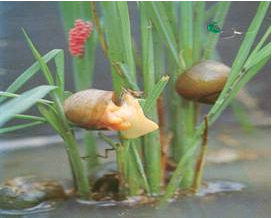First reported in Kenya in 2020, the invasive apple snail has quickly become one of the leading pest concerns for Mwea rice farmers reducing yields by 14 per cent and incomes by 60 per cent.
The spread of this highly invasive pest which affects paddy-grown rice could have dire consequences for rice production and food security in Kenya as well as the potential to spread to other rice-growing regions in Kenya and across Africa.
Since its discovery, it has spread to over 90 per cent of the Mwea Rice scheme and adjacent rice out-grower farms. This has been facilitated by the sharing of equipment amongst farmers, water distribution channels, and flooding.
According to agriculture research institute CABI, an adult apple snail can destroy a square meter of rice in one night. Females lay up to 3,000 eggs overnight with a 90 per cent survival rate and a four-year life span. This makes getting rid of the pest extremely difficult.
Related News: New rainfed rice could unlock thousands of acres, save Kenya billions in imports
Related News: Vegetable rot cancer risk for Kenyans
“Pesticides have been ineffective”
Located in Kirinyaga County, Mwea irrigation scheme accounts for 80 per cent of Kenya’s 186,000 MT of locally produced rice. Its increased expansion and production capacity are key to the government’s efforts to reduce the country’s reliance on imported rice.
Despite an anticipated bumper harvest in 2024, Mwea Irrigation’s manager, Ariemba Ateka, alarmingly informed that the government has been unable to control the invasive snail which has affected many farmers.
“Despite the launch of a pilot project to eliminate the snails, pesticides have been ineffective. Farmers have been forced to use cultural methods such as management of water levels to fight them,” he said.
In a survey conducted by CABI, 85 per cent of farmers reported apple snail attacks on their crop in 2023. Extension agents stated that the apple snail is one of farmers’ top five complaints and agro-dealers reported that 70 per cent of complaints daily were due to apple snails.
Overall, the rice cultivated area affected by apple snails remained relatively low at 11 per cent. However, farmers who were at least moderately affected by apple snail infestation suffered reductions in rice yield and net rice income of roughly 14 per cent and 60 per cent respectively. Most of the damage is done in the young rice seedlings, direct seeded crop, and newly transplanted rice.
Apple Snail Management
On average, an extra Sh20,000 was added per hectare in labour and production costs and for pesticide purchased to control the snail.
Related News: Could Western Kenya become country’s new rice bowl?
Despite being laborious, hand collecting and crushing apple snails has been reported as the most common effective control method used by farmers. Other common control methods deployed by farmers are placing nets at the water entryways, draining paddies, and constructing small trenches along the edge of rice plots– snails are concentrated in these deeper parts when the water is drained allowing for ease of collection.
Additional control methods reported by farmers were placing bamboo stakes around their rice fields. This provided the snails with ideal egg-laying sites. These bamboo are then removed and the eggs are discarded.
Most farmers also perform weeding of canals to reduce the snail’s habitats/hiding places and laying areas.
CABI which has been at the forefront of combatting the apple snail menace recommends that farmers drain water canals and paddy fields killing the snails by exposure to harsh conditions and predators such as birds and snakes.
Other practices recommended by CABI for farmers include:
- Creating barriers in feeder lines to trap the snails,
- Alternate wetting and drying,
- Draining paddy fields,
- Cleaning canals
- Digging furrows at the end of the farm so that the water in the furrows traps the apple snails.
Due to a lack of registered molluscicides in the country, as yet, there is no legally recommended chemical for apple snail control.
The National Irrigation Authority is currently working with the Pest Control Products Board (PCPB) on trials and fast-tracking pesticide registration.
Risk of Spread
The Apple snail, Pomacea canaliculate, is one of the most invasive rice pests in Southeast Asia causing serious agri-economic and ecological damage as well as impacting human health. If its spread in Kenya is not arrested in time, it will inevitably move to other rice irrigation schemes in Kenya and the region.
